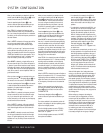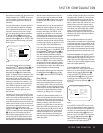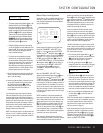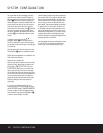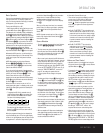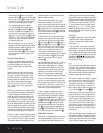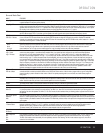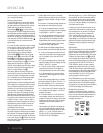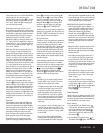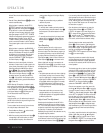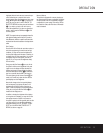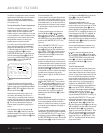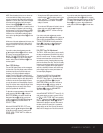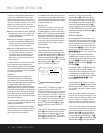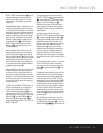
OPERATION
32 OPERATION
owner’s manual for your DVD player for more informa-
tion on making these settings.
Selecting a Digital Source
To utilize either digital mode, you must have properly
connected a digital source to the AVR 430. Connect
the digital outputs from DVD players, HDTV receivers,
satellite systems or CD players to the
Optical or
Coaxial Inputs JK . In order to provide a
backup signal and a source for analog stereo recording,
the analog outputs provided on digital source equipment
should also be connected to their appropriate inputs on
the AVR 430 rear panel (e.g., connect the analog stereo
audio output from a DVD to the
DVD Audio Inputs
on the rear panel when you connect the source’s
digital outputs).
If you have not already configured an input for a digital
source using the on-screen menus as shown on page
21, first select the input using the remote or front
panel controls, as outlined in this manual. Next,
select the digital source by pressing the
Digital
Select Button
pF and then using the
⁄
/
¤
Navigation Button o on the remote or the
‹
/
›
Button H on the front panel to
choose any of the
OPTICAL or COAXIAL
inputs, as they
appear in the
Upper Display Line # or on-screen
display. When the digital source is playing, the
AVR 430 will automatically detect which type of digital
data stream is being decoded and display that infor-
mation in the
Upper Display Line #.
When both a digital and an analog connection are
made between a source device and the AVR, the digi-
tal input is the default. If the digital stream is not pres-
ent or is interrupted, the unit will automatically switch
over to the analog inputs for the selected source.
Digital Bitstream and Surround Mode Indications
When a digital source is playing, the AVR 430 senses
the type of bitstream data that is present. Using this
information, the correct surround mode will automati-
cally be selected. For example, DTS bitstreams will
cause the unit to switch to DTS decoding, and Dolby
Digital bitstreams will enable Dolby Digital decoding.
When the unit senses PCM data from CDs or LDs, you
may select any of the standard surround modes, such
as Dolby Pro Logic II or Logic 7. Since the range of
available surround modes is dependent on the type of
digital data that is present, the AVR 430 shows you
what type of signal is present. This will help you to
understand the choice of modes.
When a digital source is first detected, the AVR 430
will display a message to indicate the type of bitstream
being received. This message will appear shortly after
an input or surround mode is changed, and will remain
in the
Lower Display Line $ for about five seconds
before that portion of the display returns to the normal
surround mode indication.
For Dolby Digital and DTS sources, a three-digit
indication will appear, showing the number of channels
present in the data. An example of this type of display
is 3/2/.1.
The first number in the display message indicates how
many discrete front-channel signals are present.
• A “3” tells you that separate front left, center and
front right signals are available. This will be displayed
for Dolby Digital 5.1 and DTS 5.1 programs.
• A “2” tells you that separate front left and right sig-
nals are available, but there is no discrete center
channel signal. This will be displayed for Dolby
Digital bitstreams that have stereo program material.
• A “1” tells you that there is only a mono channel
available in the Dolby Digital bitstream.
The middle number in the display message indicates
how many discrete surround channel signals are present.
• A "3" tells you that separate, discrete left surround,
center surround and right surround signals are pres-
ent. This is available only on discs with DTS-ES
digital audio.
• A “2” tells you that separate surround left and right
signals are available. This will be displayed for Dolby
Digital 5.1 and DTS 5.1 programs.
• A “1” tells you that there is only a single, surround-
encoded surround channel. This will appear for
Dolby Digital bitstreams that have matrix encoding.
• A “0” indicates that there is no surround channel
information. This will be displayed for two-channel
stereo programs.
The last number indicates whether there is a discrete
low-frequency effects (LFE) channel. This is the “.1” in
the common abbreviation of “5.1” sound and it is a
special channel that contains only bass frequencies.
• A “.1” tells you that an LFE channel is present. This
will be displayed for Dolby Digital 5.1 and DTS 5.1
programs, as available.
• A “0” indicates that there is no LFE channel infor-
mation available. However, even when there is no
dedicated LFE channel, low-frequency sound will be
present at the subwoofer output when the speaker
configuration is set to show the presence of a
subwoofer.
• The information in the right side of the display will
tell you if the digital audio data contains a special
flag signal that will automatically activate the appro-
priate 6.1 or 7.1 mode. This will be shown as
EX-ON or EX-OFF for Dolby Digital bitstreams and
ES-ON or ES-OFF for DTS bitstreams.
When Dolby Digital 3/2/.1 or DTS or DTS-ES signals
are being played, the AVR will automatically switch to
the proper surround mode, and no other processing
may be selected. When a Dolby Digital signal with a
3/1/0 or 2/0/0 signal is detected, you may select any
of the Dolby surround modes.
It is always a good idea to check the readout for the
channel data to make certain that it matches the audio
logo information shown on the back of a DVD pack-
age. In some cases, you will see an indication for
“2/0/0” even when the disc contains a full 5.1, or
3/2/.1, signal. When this happens, check the audio
output settings for your DVD player or the audio menu
selections for the specific disc being played to make
certain that the player is sending the correct signal
to the AVR.
PCM Playback
PCM is the abbreviation for Pulse Code Modulation,
which is the type of digital signal used for standard CD
playback, and other non-Dolby Digital and non-DTS
digital sources such as Mini-Disc. When a PCM signal
is detected, the
Lower Display Line $ will briefly
show a message with the letters PCM, in addition to a
readout of the sampling frequency of the digital signal.
In most cases, this will be
PCM 44.1kHz or
PCM 48kHz, though in the case of specially
mastered, high-resolution audio discs, you will see a
PCM 96kHz indication. Note that the sampling
rate displayed is that of the incoming digital signal, and
not the upsampled rate that may be applied to PCM
sources when Dolby Pro Logic or Pro Logic II pro-
cessing is applied, as shown on page 21.
During PCM playback you may select any surround
mode except one of the Dolby Digital or DTS/DTS-ES
modes. However, when a CD with HDCD encoding is
being played you must select the Surround Off (stereo)
mode to take advantage of the HDCD process.
Speaker/Channel Indicators
In addition to the bitstream indicators, the AVR 430
features a set of unique channel-input indicators that
tell you how many channels of digital information are
being received and/or whether the digital signal is
interrupted (see Figure 14).
Figure 14
32
36
33



